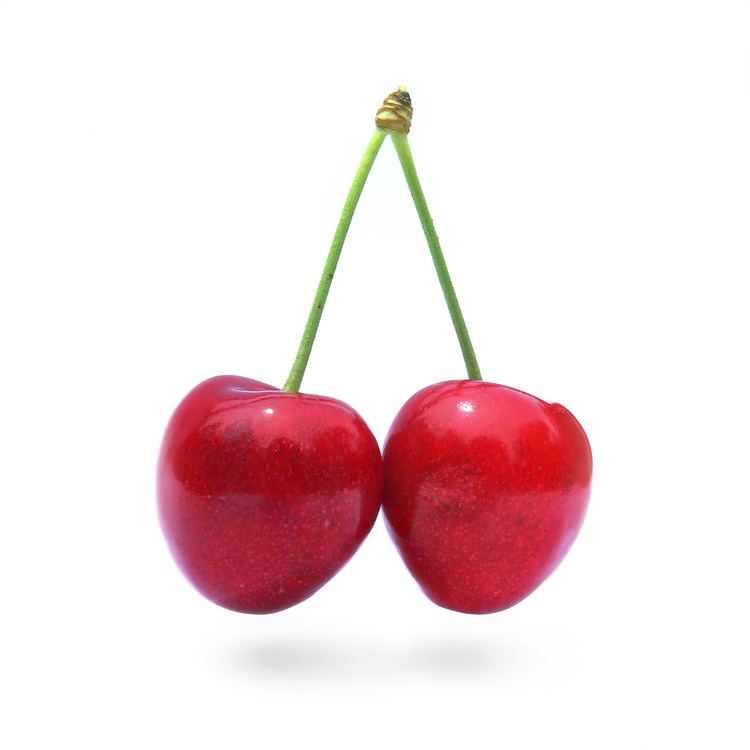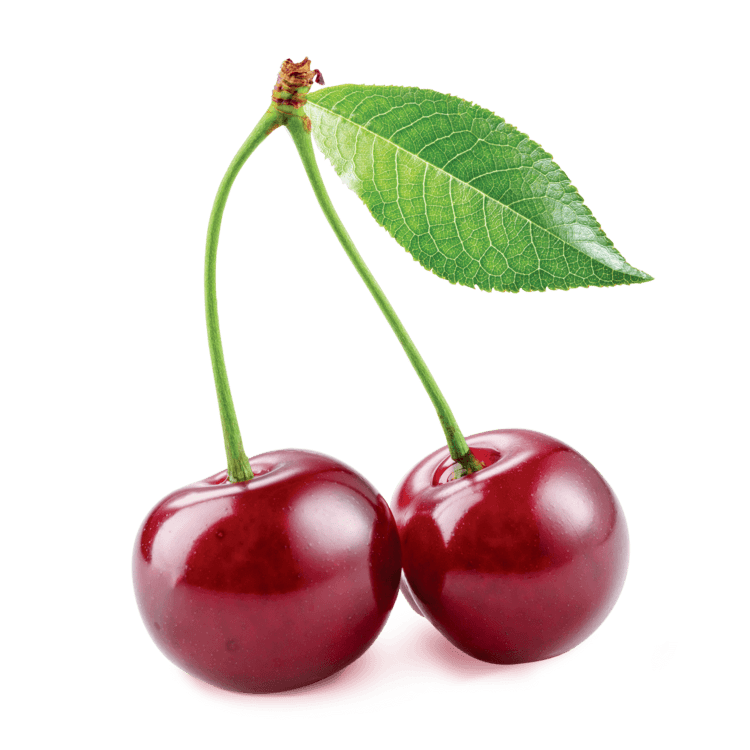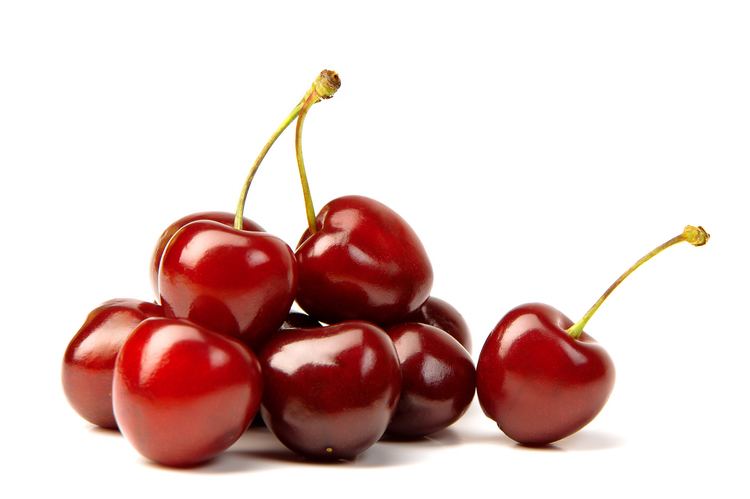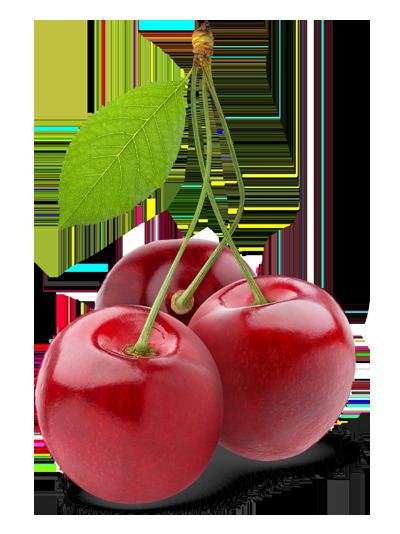Energy 209 kJ (50 kcal) Sugars 8.5 g Fat 0.3 g | Carbohydrates 12.2 g Dietary fiber 1.6 g Protein 1 g | |
 | ||
Similar Fruit, Strawberry, Peach, Blueberry, Pear | ||
Benefits of cherry fruit cherries
A cherry is the fruit of many plants of the genus Prunus, and is a fleshy drupe (stone fruit).
Contents
- Benefits of cherry fruit cherries
- Botany
- Etymology and antiquity
- Cultivation
- Growing season
- Pests and diseases
- Cultivars
- Production
- Middle East
- Europe
- North America
- Australia
- Nutritional value
- Other uses
- Species
- References

The cherry fruits of commerce usually are obtained from a limited number of species such as cultivars of the sweet cherry, Prunus avium. The name 'cherry' also refers to the cherry tree, and is sometimes applied to almonds and visually similar flowering trees in the genus Prunus, as in "ornamental cherry", "cherry blossom", etc. Wild cherry may refer to any of the cherry species growing outside of cultivation, although Prunus avium is often referred to specifically by the name "wild cherry" in the British Isles.

Botany

Many cherries are members of the subgenus Cerasus, which is distinguished by having the flowers in small corymbs of several together (not singly, nor in racemes), and by having smooth fruit with only a weak groove along one side, or no groove. The subgenus is native to the temperate regions of the Northern Hemisphere, with two species in America, three in Europe, and the remainder in Asia. Other cherry fruits are members of subgenus Padus.

Most eating cherries are derived from either Prunus avium, the sweet cherry (also called the wild cherry), or from Prunus cerasus, the sour cherry.
Etymology and antiquity
The English word cherry derives from French cerise, Spanish cereza, and Turkish kiraz, all originating from the Latin cerasum, referring to an ancient Greek region near Giresun, Turkey from which cherries were first thought to be exported to Europe.
The indigenous range of the sweet cherry extends through most of Europe, western Asia and parts of northern Africa, and the fruit has been consumed throughout its range since prehistoric times. A cultivated cherry is recorded as having been brought to Rome by Lucius Licinius Lucullus from northeastern Anatolia, also known as the Pontus region, in 72 BC.
Cherries were introduced into England at Teynham, near Sittingbourne in Kent by order of Henry VIII who had tasted them in Flanders.
Cultivation
The cultivated forms are of the species sweet cherry (P. avium) to which most cherry cultivars belong, and the sour cherry (P. cerasus), which is used mainly for cooking. Both species originate in Europe and western Asia; they do not cross-pollinate. Some other species, although having edible fruit, are not grown extensively for consumption, except in northern regions where the two main species will not grow. Irrigation, spraying, labor, and their propensity to damage from rain and hail make cherries relatively expensive. Nonetheless, demand is high for the fruit. In commercial production, cherries are harvested by using a mechanized 'shaker'. Hand picking is also widely used to harvest the fruit to avoid damage to both fruit and trees.
Common rootstocks include Mazzard, Mahaleb, Colt, and Gisela Series, a dwarfing rootstock that produces trees significantly smaller than others, only 8 to 10 feet (2.5 to 3 meters) tall. Sour cherries require no pollenizer, while few sweet varieties are self-fertile.
Growing season
Like most temperate-latitude trees, cherry seeds require exposure to cold to germinate (an adaptation which prevents germination during the autumn, which would then result in the seedling being killed by winter temperatures). The pits are planted in the autumn (after first being chilled) and seedlings emerge in the spring. A cherry tree will take three to four years in the field to produce its first crop of fruit, and seven years to attain full maturity. Because of the cold-weather requirement, none of the Prunus genus can grow in tropical climates.
Cherries have a short growing season and can grow in most temperate latitudes. Cherries blossom in April (in the Northern Hemisphere) and the peak season for the cherry harvest is in the summer. In southern Europe in June, in North America in June, in England in mid-July, and in southern British Columbia (Canada) in June to mid-August. In many parts of North America, they are among the first tree fruits to flower and ripen in mid-Spring.
In the Southern Hemisphere, cherries are usually at their peak in late December and are widely associated with Christmas. 'Kordia' is an early variety which ripens during the beginning of December, 'Lapins peak' ripens near the end of December, and 'Sweethearts' finish slightly later.
Pests and diseases
Generally, the cherry can be a difficult fruit tree to grow and keep alive. In Europe, the first visible pest in the growing season soon after blossom (in April in western Europe) usually is the black cherry aphid ("cherry blackfly", Myzus cerasi), which causes leaves at the tips of branches to curl, with the blackfly colonies exuding a sticky secretion which promotes fungal growth on the leaves and fruit. At the fruiting stage in June/July (Europe), the cherry fruit fly (Rhagoletis cingulata and Rhagoletis cerasi) lays its eggs in the immature fruit, whereafter its larvae feed on the cherry flesh and exit through a small hole (about 1mm diameter), which in turn is the entry point for fungal infection of the cherry fruit after rainfall. In addition, cherry trees are susceptible to bacterial canker, cytospora canker, brown rot of the fruit, root rot from overly wet soil, crown rot, and several viruses.
Cultivars
The following cultivars have gained the Royal Horticultural Society's Award of Garden Merit:
See cherry blossom and Prunus for ornamental trees.
Production
In 2014, world production of sweet cherries was 2.25 million tonnes, with Turkey producing 20% of this total. Other major producers of sweet cherries were the United States and Iran. World production of sour cherries in 2014 was 1.36 million tonnes, led by Russia, Ukraine and Turkey.
Middle East
Major commercial cherry orchards in West Asia are in Turkey (mainly Anatolia), Iran, Syria, Uzbekistan, Lebanon (Bekaa Valley), and Israel (Golan Heights, Gush Eztion and Northern Galilee).
Europe
Major commercial cherry orchards in Europe are in Turkey, Italy, Spain and other Mediterranean regions, and to a smaller extent in the Baltic States and southern Scandinavia.
In France since the 1920s, the first cherries of the season come in April/May from the region of Céret (Pyrénées-Orientales), where the local producers send, as a tradition since 1932, the first crate of cherries to the president of the Republic.
North America
In the United States, most sweet cherries are grown in Washington, California, Oregon, Wisconsin, and Michigan. Important sweet cherry cultivars include Bing, Ulster, Rainier, Brooks, Tulare, King, and Sweetheart. Both Oregon and Michigan provide light-colored 'Royal Ann' ('Napoleon'; alternately 'Queen Anne') cherries for the maraschino cherry process. Most sour (also called tart) cherries are grown in Michigan, followed by Utah, New York, and Washington. Sour cherries include 'Nanking' and 'Evans'. Traverse City, Michigan claims to be the "Cherry Capital of the World", hosting a National Cherry Festival and making the world's largest cherry pie. The specific region of northern Michigan known for tart cherry production is referred to as the "Traverse Bay" region.
Native and non-native sweet cherries grow well in Canada's provinces of Ontario and British Columbia where an annual cherry fiesta has been celebrated for seven consecutive decades in the Okanagan Valley town of Osoyoos. In addition to the Okanagan, other British Columbia cherry growing regions are the Similkameen Valley and Kootenay Valley, all three regions together producing 5.5 million kg annually or 60% of total Canadian output. Sweet cherry varieties in British Columbia include Rainier, Van, Chelan, Lapin, Sweetheart, Skeena, Staccato, Christalina and Bing.
Australia
In Australia, cherries are grown in all the states except for the Northern Territory. The major producing regions are located in the temperate areas within New South Wales, Victoria, South Australia and Tasmania. Western Australia has limited production in the elevated parts in the southwest of the state. Key production areas include Young, Orange and Bathurst in New South Wales, Wandin, the Goulburn and Murray valley areas in Victoria, the Adelaide Hills region in South Australia, and the Huon and Derwent Valleys in Tasmania.
Key commercial varieties in order of seasonality include 'Empress', 'Merchant', 'Supreme', 'Ron's seedling', 'Chelan', 'Ulster', 'Van', 'Bing', 'Stella', 'Nordwunder', 'Lapins', 'Simone', 'Regina', 'Kordia' and 'Sweetheart'. New varieties are being introduced, including the late season 'Staccato' and early season 'Sequoia'. The Australian Cherry Breeding program is developing a series of new varieties which are under testing evaluation.
The New South Wales town of Young is called the "Cherry Capital of Australia" and hosts the National Cherry Festival.
Nutritional value
As raw fruit, sweet cherries provide little nutrient content per 100 g serving (nutrient table). Dietary fiber and vitamin C are present in moderate content while other vitamins and dietary minerals each supply less than 10% of the Daily Value (DV) per serving, respectively (table).
Compared to sweet cherries, raw sour cherries contain slightly higher content per 100 g of vitamin C (12% DV) and vitamin A (8% DV) (table).
Other uses
Cherry wood is valued for its rich color and straight grain in manufacturing fine furniture, particularly desks, tables and chairs.
Species
The list below contains many Prunus species that bear the common name cherry, but they are not necessarily members of the subgenus Cerasus, or bear edible fruit. For a complete list of species, see Prunus. Some common names listed here have historically been used for more than one species, e.g. "rock cherry" is used as an alternative common name for both P. prostrata and P. mahaleb and "wild cherry" is used for several species.
